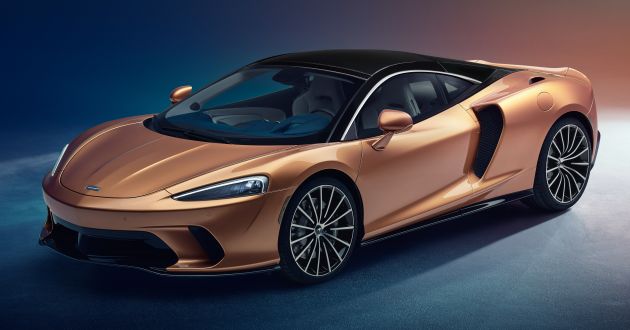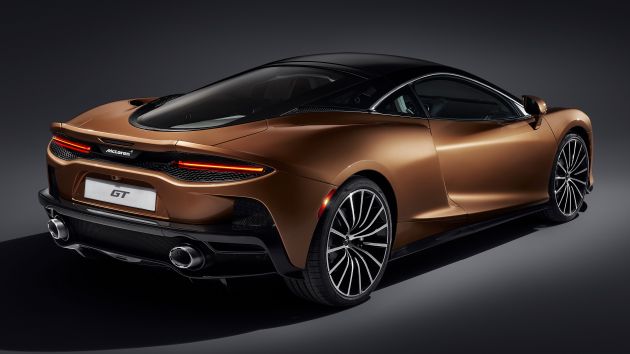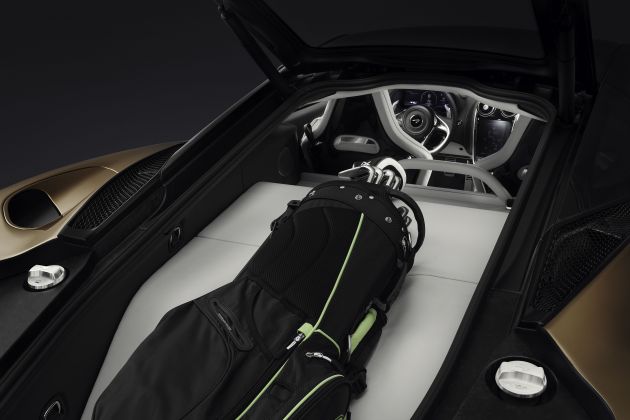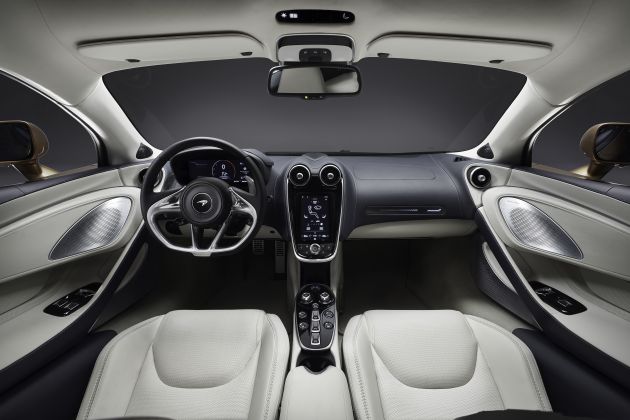The McLaren brand may be all about scintillating performance, but the company is going the opposite direction with its new grand tourer, imaginatively called the GT. Okay, maybe not completely the opposite direction, but this car is meant to take comfort, practicality and luxury and combine them with the kind of driving experience that only Woking can deliver.
In order to do that, McLaren has created a car that is its own distinct product, separate from its Sports, Super and Ultimate Series of vehicles. Unlike its first foray, the 570GT, the GT has been built from the ground up to offer greater space and usability, whilst retaining the mid-engined format. It all starts under the skin, with the carbon fibre MonoCell II-T (for Touring) monocoque gaining a lightweight rear upper structure.
That, along with the lower engine height and the repositioning of the exhausts, allows the addition of a 420 litre boot behind the seats (this car is still a strict two-seater, mind) that McLaren says will fit golf bag or two pairs of 185 cm skis and boots, together with luggage.
Those items aren’t going to be afforded much in the way of privacy, however, as on top of it lies a full-length glass tailgate – which is top-hinged rather than side-hinged as on the 570GT – that for the first time can be optioned with power operation. A separate 150 litre boot in the front of the car brings the total number of luggage space up to 570 litres, which is more than what you’d get in a Honda City.
Another important part of a grand tourer’s remit is cross-country comfort, so the GT gets unique engine mounts that are half as stiff as the 600LT‘s, while additional sound deadening reduces low-frequency sounds from the carbon structure. McLaren claims that in Comfort mode, this car is its most refined yet.
Interestingly, the GT doesn’t get the Proactive Chassis Control cross-linked damping that gives the 720S otherworldly levels of ride comfort. Instead, it has a more conventional suspension setup and a new Proactive Damping Control, which uses sensors to scan the road, predict what will happen next and react in just two milliseconds. The suspension is tuned for occupant comfort and optimised vertical load and tyre contact patch, although the three driving modes – Comfort, Sport and Track – have their own set of parameters.
Elsewhere, the hydraulic power steering and brakes (cast iron as standard, carbon ceramics optional) provide greater assistance at low speeds, while the tyres are bespoke Pirelli P Zero rubber that balance the needs of high-performance driving, comfort and refinement. The rollers are wrapped around 21-inch alloy wheels at the rear – the largest ever fitted to a McLaren – and 20s at the front, available in seven- and 15-inch designs.
Despite the concessions for comfort and refinement, do not for one second be fooled into thinking that the GT is slow. Under the rear boot floor lies McLaren’s stalwart 4.0 litre twin-turbocharged V8, redeveloped for this application to deliver 620 PS at 7,500 rpm and 630 Nm of torque from 5,500 to 6,500 rpm, with more than 95% of that torque available from 3,000 rpm to 7,250 rpm. A seven-speed dual-clutch transmission remains.
Even with all the mod cons on board, the carbon-bodied GT still weighs just 1,530 kg at the kerb, which McLaren says is 130 kg lighter than its closest competitor. With a resulting power-to-weight ratio of 405 PS per tonne, the GT is blisteringly quick – from a standing start, it will hit 100 km/h in 3.2 seconds, blast past 200 km/h in nine seconds flat and will hit a top speed of 326 km/h.
At nearly 4.7 metres long, the GT is longer than anything in the Sports and Super Series, and the flowing exterior lines takes advantage of that considerable length to great effect. The design is much less overtly aggressive than the other models, with more body-coloured bodywork and less contrasting elements giving the car a calmer, more elegant appearance.
The slim half moon-shaped headlights – part of the “hammerhead line” that visually broadens the car – remains, but the front air intakes are cleaner, while the tall rear haunches house the large side inlets that feed the high-temperature radiators. At the rear, a dramatic scalloped section underneath the integrated rear spoiler features a pair of tail light beams, and the rear diffuser houses the low-mounted tailpipes.
Typical McLaren cues include the fully-glazed, teardrop-shaped glasshouse and the dihedral doors. Step inside and you’ll find an interior that will be familiar to 570S owners, but with a few unique details. Firstly, there’s Nappa leather upholstery as standard, with soft-grain luxury leather and Alcantara available as options; cashmere fabric will also be offered at the end of the year.
This upholstery extends to the boot, but you can also specify a SuperFabric lining that features tiny armoured guard plates to increase durability while being breathable, easy to clean and quick to dry. Moving back to the front of the cabin, machined and knurled aluminium switches and controls – including the steering wheel-mounted gearshift paddles – replace the carbon trim on most McLarens and are paired to gloss black decor.
Also new is the infotainment system, which replaces the Iris interface on previous models. Through the seven-inch portrait touchscreen, the system is said to be among the fastest in any car, with Here navigation mapping, real-time traffic data and integrated controls for the climate control. There’s also an optional 12-speaker Bowers & Wilkins sound system with carbon fibre subwoofers and Kevlar mid-range drive units.
Ahead of the driver sits a 12.3-inch digital instrument display that shows turn-by-turn navigation, phone calls and even the feed from the optional reverse camera to keep the driver’s eye level high. Above them, an electrochromic glass roof can be specced to replace the standard carbon roof. The GT is available for order worldwide, with deliveries kicking off by the end of 2019. Pricing in the UK starts at £163,000 (RM870,600).
Source: Read Full Article




